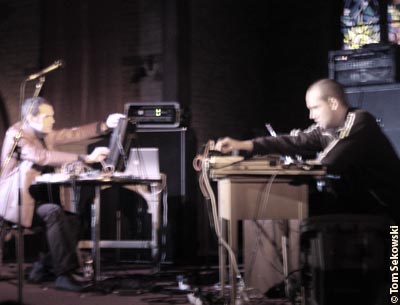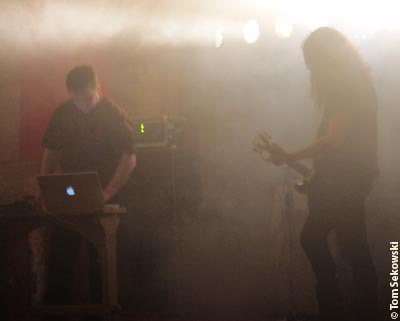 |
|
|
|
|
Cooking a Tasty Ear-Drum-Crunching Soup
Report and photos by Tom Sekowski |
| This could’ve been billed as the night of electronic volume extremity or the night a number of those in the audience lost their hearing. Two duos — one based in its entirety in Austria, while the second one being partly Austrian and partly American.
Németh was chosen as the opener this night. Németh is actually composer / electronic experimental guru Stefan Németh. As co-founder of the Vienna based Mosz label, member of Lokai and Radian, he has also collaborated with people as diverse as Toshimaru Nakamura, Florian Hecker, Oskar Aichinger, Fennesz and dozens of others. Though I followed a large part of his work through the years, I wanted to get an idea how stripped down Németh’s music would be in a live format. Imagine my surprise when I learned the live Németh experience was made up not only of the leader but featured guitarist Martin Siewert. What a treat this was going to be! I could sense an invisible tension between the two musicians already, or was I simply imagining it? But wait — I’m getting ahead of myself.
While Németh plugged in his synth and patched the wires on the console, Siewert began to run cyclical patterns along the strings of the guitar he laid out on the table in front of him. Heavy pedal manipulations lead to a multitude of varying layers of whooshing sounds buzzing from the speakers and here comes the most difficult part — trying to describe what occurred over the course of the next hour. The first piece was full of inventive peaks and valleys as the two men played off each other. As Siewert was alternating between the tabletop guitar and the one he had sitting beside him, Németh was plugging in solid walls of trembling bass. Imagine my surprise to be accosted by crunchy beats that were exhibited throughout, even though these came in chunks and never constituted a rhythmic structure per se.
|
|
The second piece was a brief wall of feedback meshed with brittle synth noises, at which point the duo returned to exploring a subtler means of communication. What I loved the best about their performance is how it moved through phases, whistling from one end of the spectrum to the next. One minute, they would play around with feedback and form it into a wall of still bearable noise; the next, they would mould crafty little packets of rhythmic idioms that would be killed off at their whim. Németh was especially good at giving birth to effortless shifts on his synth, which bounced off Siewert’s constant creative orgies on the pedals laid out beside his guitar. In fact, I was shocked at how quickly he would punch the pedals and move the volume knobs consecutively. All of this led me to the conclusion this duo had little prepared in terms of actual material. They were playing by the seats of their proverbial pants and this sort of improvisation is what works best when you’re not second-guessing your partner’s intentions. Having played in so many contexts previously, meant these two were communicating on the same bandwidth.
|
|

Stefan Németh & Martin Siewert |
|

Peter Rehberg & Stephen O’Malley |
|
|
| Following a brief intermission and some set up (smoke machine, lights, laptop plug in), KTL was revved up to go. Made up of two music heavyweights from two distinct categories — guitarist Stephen O’Malley representing the doom metal world and electronic guru Peter Rehberg (a.k.a. Pita) representing all that is good in the realm of experimental music. Looking around the church, I wondered whom the majority of the crowd was there to see? Were they after the pure, harsh guitar wallop of Sunn O)))’s O’Malley or did they worship at the altar of Pita’s electronic world?
As the smoke filled the church, that question ceased to matter. In the darkened, smoke-filled church the spotlights were propped high, obscuring the two musicians buried somewhere in the mist. (There was so much smoke in the church; all that was visible were the outlines of the two musicians along with the logo on Rehber’s Mac.) O’Malley began the proceedings with a bluesy guitar riff that promised an enjoyable enough mass. Just then Pita began to work his magic. As he processed O’Malley’s guitar riff, O’Malley in turn began to play faster, spinning circles of riffs on top of the original one. At times, he would turn towards the amps to allow feedback to do its part. As the massive amounts of feedback flowed from the speakers, Rehberg concocted a mix of skewed, jittery beats that were juicy on the bass end of the spectrum. These would come in spurts and would later be replaced by thickly steaming high-pitched heaps of electronic madness.
The wall of sound was pure but make no mistake, it was deathly loud. I witnessed a number of people hold on to their ears to save the last remnants of their hearing. The wallop the duo cooked up over the next hour is worthy of the name pure, unabashed noise. In the density, there was stark beauty. In the madness, as my torso was gyrating, I felt as if my body was moved by force a few rows back. Metallic-electronica only for those brave enough to accept the calling, KTL’s show will remain the measuring stick by which all future shows of such intensity are bound to be measured.
Special thanks go out to the mysterious stranger who threw me a set of earplugs after he witnessed me reel in utter pain. Without you, I bet my ear drums would be severely damaged at this very moment.
|
|
|
|
|
|



